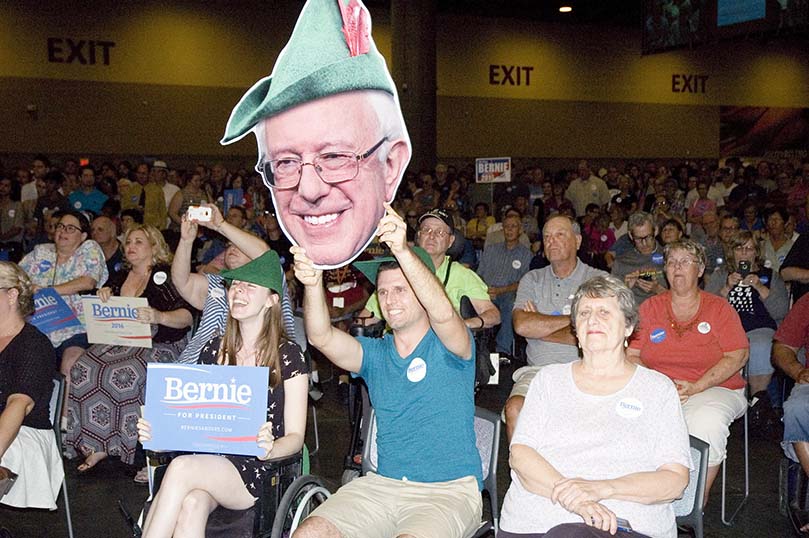
Editor’s Note: Below are some questions the party discussed in a report to its National Board by Joelle Fishman chair of the CPUSA’s Political Action Commission. When the report was given the framework was Hillary Clinton’s winning the Democratic primary by a half point in a virtual tie in Kentucky, Bernie Sanders carrying Oregon and Donald Trump besting the Oregon GOP contest. The remaining primaries are in California, New Jersey, Montana, New Mexico, South Dakota, North Dakota (June 7) and D.C. (June 14).
1. With Donald Trump as the presumptive nominee of the Republicans and more Republicans beginning to rally round him, the big challenge is to forge the kind of broad, peoples’ unity necessary to defeat him. That means educating folks about what side Trump is really on. There are big stakes for working-class families and communities in the elections. Trump follows a neo-fascist plan. He has used racism as a major organizing tool. He poses as an outsider and anti-establishment, and he sometimes uses populist rhetoric to attack Wall Street. But on most issues, Trump would pursue the agenda shared by all Republican candidates: slash taxes for the wealthy; use budget deficits as an excuse to slash education, health, housing, environment, and all government functions (except the military); attack unions and force workers to compete for jobs in a race to the bottom; remove any government oversight or regulation of corporate behavior; repeal the Affordable Care Act and Dodd-Frank; create divisions by attacking immigrants, African American communities and women.
There is a lot of confusion regarding Trump and this includes working people and union members. We know that Working America has already taken on door-to-door education of union members in areas of the midwest where white union members voted twice for President Obama and where some are now attracted to Trump. One on one conversations have been able to turn around the false idea that a businessman is the answer to job creation, or that this is possible in a divisive, racist framework. For example, in Connecticut unions are discussing plans for a major summer mobilization dedicated to internal member education. Along with this is the need for all out voter registration and get-out-the-vote methods. The Peoples World “Vote” promotional card that has been prepared is designed to sign up new readers at the same time voter registration is taking place. It should help increase readership of People’s World campaign news and analysis aimed at increasing participation and creating unity to defeat the extremist right-wing. We also plan to update and re-issue the “Immigration – Myths v. Facts” pamphlet.
Donald Trump’s poison is not just confined to the presidential contest. It aims to infect attitudes of voters in the entire electoral cycle and could have a negative impact on turnout in Congressional and state races as well. The threat of a Trump presidency ups the ante for electing a Democratic-majority Senate and House. Many states have key races where the labor movement and allies are focused.
2. Both Bernie Sanders and Hillary Clinton are taking on Donald Trump in their campaigning. The amazing crowds that continue to come out for Bernie Sanders show deep support for the more advanced program he is presenting.
The huge Sanders rally in Carson California on the night of the Kentucky and Oregon primaries attracted a multi-racial and multi-generational crowd and is an exciting example of the election’s left progressive potential.
The big challenges posed by the Sanders political revolution are building unity to defeat Trump and developing forms in which it will stay together through November and beyond to build support on the issues and elect local progressive candidates.
The political revolution, with all the new voters, young voters and progressive energy it represents, can be a powerful force to defeat Trump. This will require a clear understanding that, if Hillary Clinton is the nominee, not voting for her opens the door for the extreme right-wing, and closes the door on the movement for a progressive agenda. Building the movement on issues, not on candidates, can help bring together the broad forces necessary to win in November and to continue on afterward.
3. In advance of the upcoming Democratic Party convention in Philadelphia there are several initiatives addressing how to solidify the political revolution. These include: the coordination in 55 cities through the Sanders campaign to develop progressive formations in local Democratic Party structures and the People’s Summit, June 17-19 in Chicago initiated by National People’s Action, Progressive Democrats of America, Democrats for America, National Nurses United, and others to address issues related to winning a progressive agenda.
Both events will be an opportunity for the many organizations supporting Bernie Sanders to meet each other and discuss how to achieve the goals of electing local progressive candidates, democratizing elections (money out of politics, ending voter suppression etc.) and mobilizing on a common issues agenda. Hopefully defeating Donald Trump and the Republicans will be a major unifying factor shaping tactics before and after the convention.
This election poses great dangers to democracy and people’s lives. It also holds the inspiring possibilities of a victory that will expand and strengthen the labor and people’s movement. Unity and voter turnout are key.
Photo: Earchiel Johnson peoplesworld.org


 Join Now
Join Now